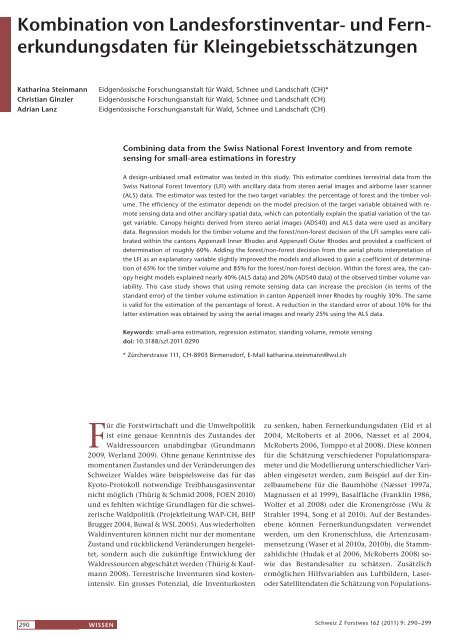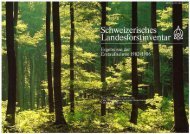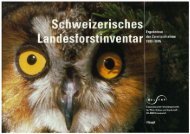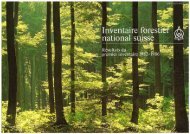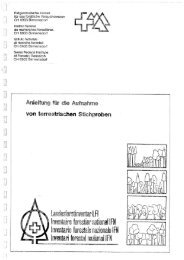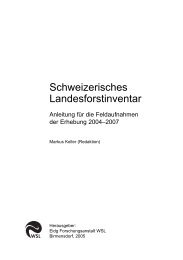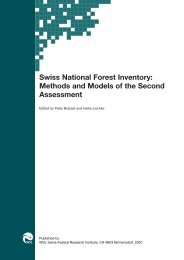30 Jahre Schweizerisches Landesforstinventar - LFI
30 Jahre Schweizerisches Landesforstinventar - LFI
30 Jahre Schweizerisches Landesforstinventar - LFI
Sie wollen auch ein ePaper? Erhöhen Sie die Reichweite Ihrer Titel.
YUMPU macht aus Druck-PDFs automatisch weboptimierte ePaper, die Google liebt.
Kombination von <strong>Landesforstinventar</strong>- und Fernerkundungsdaten<br />
für Kleingebietsschätzungen<br />
Katharina steinmann<br />
Christian Ginzler<br />
Adrian Lanz<br />
Eidgenössische Forschungsanstalt für Wald, Schnee und Landschaft (CH)*<br />
Eidgenössische Forschungsanstalt für Wald, Schnee und Landschaft (CH)<br />
Eidgenössische Forschungsanstalt für Wald, Schnee und Landschaft (CH)<br />
Combining data from the swiss national Forest inventory and from remote<br />
sensing for small-area estimations in forestry<br />
A design-unbiased small estimator was tested in this study. This estimator combines terrestrial data from the<br />
Swiss National Forest Inventory (<strong>LFI</strong>) with ancillary data from stereo aerial images and airborne laser scanner<br />
(ALS) data. The estimator was tested for the two target variables: the percentage of forest and the timber volume.<br />
The efficiency of the estimator depends on the model precision of the target variable obtained with remote<br />
sensing data and other ancillary spatial data, which can potentially explain the spatial variation of the target<br />
variable. Canopy heights derived from stereo aerial images (ADS40) and ALS data were used as ancillary<br />
data. Regression models for the timber volume and the forest/non-forest decision of the <strong>LFI</strong> samples were calibrated<br />
within the cantons Appenzell Inner Rhodes and Appenzell Outer Rhodes and provided a coefficient of<br />
determination of roughly 60%. Adding the forest/non-forest decision from the aerial photo interpretation of<br />
the <strong>LFI</strong> as an explanatory variable slightly improved the models and allowed to gain a coefficient of determination<br />
of 65% for the timber volume and 85% for the forest/non-forest decision. Within the forest area, the canopy<br />
height models explained nearly 40% (ALS data) and 20% (ADS40 data) of the observed timber volume variability.<br />
This case study shows that using remote sensing data can increase the precision (in terms of the<br />
standard error) of the timber volume estimation in canton Appenzell Inner Rhodes by roughly <strong>30</strong>%. The same<br />
is valid for the estimation of the percentage of forest. A reduction in the standard error of about 10% for the<br />
latter estimation was obtained by using the aerial images and nearly 25% using the ALS data.<br />
Keywords: small-area estimation, regression estimator, standing volume, remote sensing<br />
doi: 10.3188/szf.2011.0290<br />
* Zürcherstrasse 111, CH-8903 Birmensdorf, E-Mail katharina.steinmann@wsl.ch<br />
Für die Forstwirtschaft und die Umweltpolitik<br />
ist eine genaue Kenntnis des Zustandes der<br />
Waldressourcen unabdingbar (Grundmann<br />
2009, Werland 2009). Ohne genaue Kenntnisse des<br />
momentanen Zustandes und der Veränderungen des<br />
Schweizer Waldes wäre beispielsweise das für das<br />
Kyoto-Protokoll notwendige Treibhausgasinventar<br />
nicht möglich (Thürig & Schmid 2008, FOEN 2010)<br />
und es fehlten wichtige Grundlagen für die schweizerische<br />
Waldpolitik (Projektleitung WAP-CH, BHP<br />
Brugger 2004, Buwal & WSL 2005). Aus wiederholten<br />
Waldinventuren können nicht nur der momentane<br />
Zustand und rückblickend Veränderungen hergeleitet,<br />
sondern auch die zukünftige Entwicklung der<br />
Waldressourcen abgeschätzt werden ( Thürig & Kaufmann<br />
2008). Terrestrische Inventuren sind kostenintensiv.<br />
Ein grosses Potenzial, die Inventurkosten<br />
zu senken, haben Fernerkundungsdaten (Eid et al<br />
2004, McRoberts et al 2006, Næsset et al 2004,<br />
McRoberts 2006, Tomppo et al 2008). Diese können<br />
für die Schätzung verschiedener Populationsparameter<br />
und die Modellierung unterschiedlicher Variablen<br />
eingesetzt werden, zum Beispiel auf der Einzelbaumebene<br />
für die Baumhöhe (Næsset 1997a,<br />
Magnussen et al 1999), Basalfläche (Franklin 1986,<br />
Wolter et al 2008) oder die Kronengrösse (Wu &<br />
Strahler 1994, Song et al 2010). Auf der Bestandesebene<br />
können Fernerkundungsdaten verwendet<br />
werden, um den Kronenschluss, die Artenzusammensetzung<br />
(Waser et al 2010a, 2010b), die Stammzahldichte<br />
(Hudak et al 2006, McRoberts 2008) sowie<br />
das Bestandesalter zu schätzen. Zusätzlich<br />
ermöglichen Hilfsvariablen aus Luftbildern, Laseroder<br />
Satellitendaten die Schätzung von Populations-<br />
290 wissen Schweiz Z Forstwes 162 (2011) 9: 290–299


